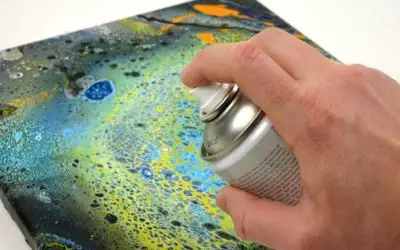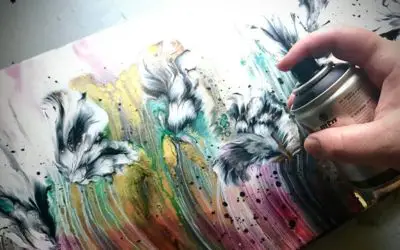Can you paint acrylic over spray paint? Creating acrylic designs over painted surfaces is common in the painters’ world.
The designs dry fast and are durable. Moreover, acrylic paints are highly adhesive and barely toxic.
So, it makes the best product for painting over a painted surface.
Unfortunately, I’ve discovered first-hand that painting over a painted surface has several challenges.
More importantly, you must observe specific rules to achieve the best results. So, I prepared this guide to help you paint acrylic designs over spray paint without common problems.
Will Acrylic Paint Stick to Spray Paint?
Yes, acrylic paint sticks to spray paint if you use the right paint and observe specific requirements.
For instance, the composition of the spray paint is critical. Water-based paint, for example, may not stick to oil-based paint.
Also, you must allow the spray paint to cure fully before applying acrylic paint. Above all, proper surface preparation is paramount.
Advantages of Using Acrylic Paint Over Spray Paint

Many painters use acrylic over spray-painted surfaces to make colours pop and add depth.
Also, acrylic paints are easy to work with, dry quickly, typically in 1-2 hours, and the clean-up process is minimal.
But most importantly, acrylic and spray paints are technically the same, except for the resins.
Acrylic paints comprise standard resins, while spray paints contain “polymer latex” binders also found in toilet cleaners, toothpaste, and other household products.
Thus the two stick to each other very well. But as we’ll find out shortly, it’s rarely as smooth sailing as you’d imagine.
Factors Affecting How Well Acrylic Paints Sticks to Spray Paints
In perfect conditions, acrylic paint sticks strongly to spray paint. Unfortunately, sometimes you may get a weak bond, depending on various factors.
Let’s round up the most important factors to help you get the best results;
The composition of the spray paint
Generally, acrylic paints stick strongly to solvent-based spray paints. Indeed, the bond may be permanent.
However, the same isn’t true for oil-based spray paints. Oil causes acrylic paint pigments to spread unevenly, like mixing oil and water.
One way around the problem is to shake the spray can thoroughly so that the oil paint mixes uniformly. Alternatively, use solvent-based spray paint.
The top coat and finish
Does the spray paint have a top coat? If so, the type of top coat matters. Some top coats are resistant to acrylic paint.
So, you may end up with a weaker bond. For instance, many top coats are waterproof. Waterproof top coats don’t mix well with acrylic paints.
The type of finish also matters. For instance, acrylic paints bond strongly to textured finishes, like eggshell or semi gloss.
Meanwhile, it forms weak bonds with extra-smooth surfaces, like semi-gloss and full gloss.
The quality of the acrylic paint
Not all acrylic paints are created equal. For instance, different manufacturers use different pigments and extenders.
Moreover, they source the solvents from different locations. Therefore, the quality varies.
The same applies to additives. For instance, some manufacturers add UV-resistant elements to slow down fading, while others include water-resistant compounds.
The additives directly impact the paint’s adhesive properties.
The painter’s skill level
We all paint differently. Unfortunately, your painting technique directly impacts the quality of the finish and how strongly the acrylic paint sticks to the spray-painted surface.
For this reason, gauge your painting skills before you begin and find someone else to handle the job if you’re not confident.
Types of Spray Paint to Use
From the foregoing discussion, it’s evident that you should select your spray paint carefully if you intend to paint over it with acrylic paint. What is the best acrylic spray paint?
We recommend the following spray paints;
- Solvent-based paints: Avoid oil-based spray paint, as acrylic paints don’t mix well with oil-based paint. Instead, consider solvent-based or water-based spray paint. But avoid latex paints.
- Glossy vs. flat spray paint: Avoid glossy paints as they contain fewer paint pigments. Unfortunately, a high-resin, low-pigment mix results in weak bonds. Instead, use flat or matte paints.
How to Test if Your Acrylic Paint Sticks to Spray Paint

So, you’re ready to begin painting. But you’re unsure if the acrylic paint will stick to the spray-painted surface. The following are a few ways to find out;
- Read the label: Always read the label to learn about the paint’s ingredients. Specifically, find out if it’s oil-based spray paint. If so, the acrylic paint won’t stick well. Additionally, check the type of resin, solvents, and binders. Are they compatible with acrylic paint?
- Test it on raw canvas: A quick trial proves you have the right paint. Find a raw canvas, cardboard, or stiff paper, apply the paint, and wait for it to dry. Then use a hard tool or knife to scratch or cut through the painted surface. A strongly adhered paint is difficult to scratch or cut through.
Applying Acrylic Paint Over Spray Paint
Now we know how to choose the right paint and test it. So, it’s time to get to work. The following is a step-by-step guide to painting acrylic over spray paint.
1. Sand down the surface
The first step is to sand the surface using sandpaper. Sanding makes the surface rough, improving the adhesive strength between the two paints.
I often use 240-grit sandpaper. However, a softer sandpaper, like 400-grit, is fine.
Coarser sandpaper grits provide an even rougher surface. However, they may damage the spray-painted material.
Alternatively, begin with an ultra-soft grit, such as 600-grit. Then go over the surface with a coarser sandpaper if you need a rougher surface.
2. Surface cleanup
After sanding, the next step is cleaning the surface to remove dirt, sanding dust, and grease/oils.
Otherwise, the layer of dirt results in a weak adhesion, compromising the quality of the painting work.
Begin by wiping the surface with a clean, lint-free cloth to remove the dirt and debris.
Alternatively, use a vacuum cleaner. Then follow up with soap and water or a degreasing agent. Be very gentle to avoid damaging the original painting.
3. Prime the surface
Many painters overlook primers. But they can make a massive difference when painting.
First, primers bring the paint colour back to normal. This is critical when painting over a pre-painted surface.
It prevents the two paint layers from mixing. Primers also block out stains and odors and seal gaps from the previous painting.
You need a thin primer layer, as thicker layers take longer to dry. Also, use water-based primers when painting acrylic over spray paint.
Most importantly, allow the surface to dry fully before you begin painting.
4. Apply acrylic paint
Now you can begin painting. I use natural-bristled brushes for the best results.
Moreover, fine natural bristles provide greater control. Again, apply thin layers, ensuring an even surface.
Going over the section twice or thrice is better than applying a thick layer at once.
If you feel you need another coat for the best results, wait for the first coat to dry fully before applying the next one.
Most acrylic paints dry within an hour. But it’s best to check the user manual.
5. Seal the spray-painted surface.
Like priming, sealing is optional but highly valuable. It “binds” the acrylic paint to the spray-painted surface below.
Also, it protects the painting from dust, water, and the sun. Otherwise, you may notice fading.
Unsurprisingly, sealing also creates a more uniform surface while intensifying the colours.
The best sealants for acrylic paints are water-based and glossy. That isn’t to say that oil-based sealants are taboo.
But water-based sealants are easier to use and require less cleanup.
6. Allow it to dry
Always let the painting dry fully before handling or applying anything else to the surface.
This crucial step protects your painting from smudges or unintended marks. It also allows the work to dry uniformly.
Fortunately, acrylic paints take only 2-3 hours to dry indoors. You may lay it flat under a ceiling fan to accelerate drying.
However, don’t dry it under direct sunlight.
Tips to Make Acrylic Paint Stick Strongly to Spray Paint

Unfortunately, a few things can go wrong, even if you follow the best procedure when painting acrylic designs over a spray-painted surface.
The following are a few secrets I use to ensure the highest quality work;
- Roughen the surface slightly before you begin: This is especially important when working on canvas. The pre-painted layer is typically smooth, making adhesion challenging. But sanding it lightly using fine-grit sandpaper provides micro-grooves for increased adhesion.
- Never apply acrylic over wet spray paint: This is the most common cause of peeling and flaking. Worse still, the spray paint may never dry properly, causing color changes down the line. So, wait for a different day if you’re in a hurry.
- Apply multiple thin layers: Thick paint layers are stubborn and take longer to dry. So, apply thin layers. They dry faster, reducing the risk of ruining your project. You’ll need several coats, which is a smaller risk than damaging the project with thick paint layers.
- A base coat and top coat go a long way: Base and top coats are an extra cost many painters are eager to eliminate. But they’re very important. Specifically, consider a clear base coat. I recommend a top coat varnish to protect the surface from weather and dirt.
Can You Mix Spray Paint with Acrylic Paint
Yes, you can mix spray paint with acrylic paint instead of using spray paint as a base layer. I’ve done it several times, and the results are excellent.
But you must mix them right. For instance, only mix water-based acrylic paint with water-based spray paint.
Otherwise, you may run into big problems. For instance, never mix water-based paint with oil-based paint. The two won’t mix well, no matter how hard you try.
You’re probably wondering whether water-based spray paints are of good quality. Yes, they are.
When first released, they were hit-and-miss. But the big brands have found ways to make quality water-based spray paints.
Most importantly, you can find many water-based spray paints without burning a hole in your pocket.
Spray Paint vs Air Brush
If you’re not a big fan of spray painting, I strongly recommend airbrushing.
Solvent-based spray paints combine wonderfully with acrylic paints. But they’re expensive and difficult to control.
Airbrushes solve both problems. They eliminate the need to restock spray paints every month.
Moreover, you can use acrylic paints in the airbrush. Doing so makes colour matching a lot easier.
The only downside is the learning curve. But airbrushes are fun to use once you learn the ropes.
FAQs
What paint sticks to spray paint?
You can use a variety of paints over spray paint, from acrylic to oil and latex. But each paint type creates a different effect when used over spray paint. Acrylic paints are the best when working with more vibrant colours as they dry slowly and have fewer colour pigments making the paint more translucent and ideal for layering. Meanwhile, oil paints are best for deep contrasts.
Can you paint over spray paint?
Yes, you can paint over spray paint, provided the surface is completely dry. But this doesn’t mean “dry to the touch,” or dry spray paint faster, as is common when painting multiple coats of the same paint. Instead, you must wait for the spray paint surface to cure fully. Sand the pre-painted surface lightly with 400-grit or higher sandpaper and apply a base coat before painting.
Can you spray paint over acrylic paint?
Yes, you can spray paint over an acrylic-painted surface. Acrylic paints are water-based, sticking to any other paint, from water-based to oil-based and latex paint. Acrylic paint gives me the best results when painting over acrylic. However, spray paints are fine if you prepare the surface properly.
Can you use acrylic paint over spray primer?
Yes, acrylic paint can be used over spray primer. For instance, if you plan to use acrylic paint over a spray-painted project, you may finish the surface using a spray primer to protect the bottom paint layer while providing a more adhesive surface for the acrylic paint coat. But the paint will only stick if applied correctly.
Can you spray paint over spray paint?
Yes, you can spray paint over a spray-painted surface. Again, ensure the first paint is fully dry (cured) before painting the new layer. Also, verify that the two paints are compatible. For instance, oil-based and water-based paints don’t mix. Finally, paint in thin coats for faster and uniform drying.
What is the difference between eggshell and flat paint?
When comparing flat vs eggshell paint, you will see that eggshell has a slight sheen, akin to an eggshell’s surface. It offers a smoother appearance than flat paint without the reflectiveness of satin or semi-gloss finishes. Flat paint, on the other hand, has no sheen, giving a matte, non-reflective finish that is best for hiding imperfections but is less washable.
Summary
You can use acrylic paint over a spray-painted surface. However, you must follow a few basic guidelines for strong adhesion.
For instance, verify that the two paints are compatible. Also, lightly sand the surface with extra-fine sandpaper and thoroughly clean it before painting. The results are beautiful if you do the job right.










Leave a Reply